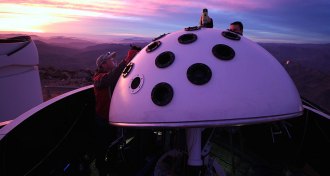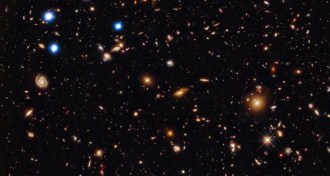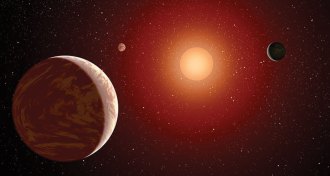All Stories
-
 Tech
Tech‘Monsters’ examines a history of technological hubris
Drawing on the Hindenburg disaster, a science writer develops criteria for recognizing risky technology.
-
 Tech
TechMoving exhibit pays tribute to lost space shuttles’ crews
At Kennedy Space Center, pieces of wreckage from the space shuttles Challenger and Columbia are on public display for the first time.
By Mark Schrope -
 Animals
AnimalsBoa suffocation is merely myth
Boa constrictors don’t suffocate prey; they block blood flow, says a new study that shatters a common myth about the snakes.
By Susan Milius -
 Astronomy
Astronomy24-eyed telescope takes full-sky movies every night
The Evryscope, a 24-telescope array in northern Chile, will nearly continuously watch for changes in the southern sky.
-
 Astronomy
AstronomyYoung black holes evade detection
Supermassive black holes should be growing in the first billion or so years after the Big Bang, but astronomers can’t find them.
-
 Science & Society
Science & SocietyA few key signs betray betrayal
Like many relationships that collapse after betrayal, teasing out what goes wrong and who is at fault in betrayal isn’t so easy.
-
 Animals
AnimalsPower of pupils is in their shape
Horizontally or vertically stretched pupils may provide predators and prey with visual advantages.
-
 Neuroscience
NeuroscienceBrain scans hint at reasons for stress-eating
Moderate stress changes brain behavior in ways that may lead to poor food choices.
-
 Animals
AnimalsGibbons have been disappearing from China for centuries
Gibbons are now found in only a small area of southwestern China. But they once thrived across much of the country, records show.
-
 Astronomy
AstronomyFaint red stars can build water worlds drip by drip
Rocky planets around faint red stars have a hard time getting water, but they’re still probably the most common habitable locales in the Milky Way, new computer simulations suggest.
-
 Neuroscience
NeuroscienceClaim of memory transfer made 50 years ago
Scientist’s claims of transferred memories were more fiction than fact.
-
 Genetics
GeneticsAncestral humans had more DNA
A new genetic diversity map marks where humans have gained and lost DNA.